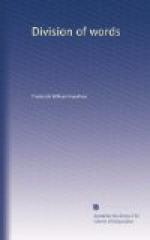The placing of the accent in English is subject to two general rules.
I The accent clings to the syllable which gives the meaning to the word, or in technical terms, the root syllable, re-call’, in-stall’, in-stal-la’-tion (accent falling on the syllable which defines the word as a noun), in-her’-it.
II Where the root syllable
is not known the accent falls on the
first syllable, with
secondary accents following at intervals to
relieve the voice.
This last tendency not infrequently supersedes the other, partly from the natural habit of the language, and partly because the average man is not an etymologist and knows very little about the derivation of the words he uses. For example, in Shakespeare’s time English people followed the first rule and said re-ven’-ue, but now we say rev’-e-nue.
These two rules will serve as a good general guide to accent. Attention should be paid to the pronunciation of good speakers, and care taken to follow it. In case of doubt the dictionary should be consulted and the proper accent carefully fixed in the mind.
DIVISION OF WORDS
When the words do not fit the line what shall we do? The early printers used only one kind of spaces. In setting a line of type they proceeded until there was no room in the line for the next complete word of the copy. Then they filled out the line with spaces and began the next word on the next line. The length of the register being known in advance and nothing but spaces being used in setting the line, the compositor was spared much that makes composition at once a hard labor and a fine art. The result was an irregular margin at the right such as we now see in typewritten letters.
With improvements in types and typography the squaring out of the page soon came into fashion. In many cases this can be done by the careful use of spaces so as to bring a certain number of words squarely out to the end of the line. There have been printers who have insisted that this should always be done. Their efforts have not, however, been successful. They result in a freakish looking page with white spots in the lines where letters or words have been spaced out to fill the register. It would be better, on the whole, to resort to the practice of the old masters and leave the right-hand margin irregular.




